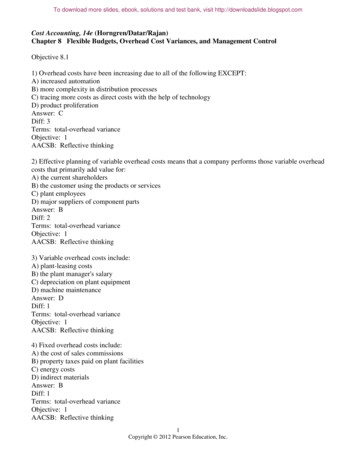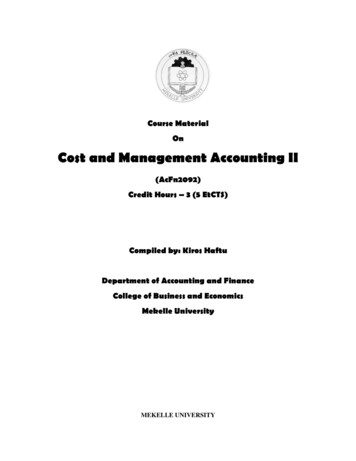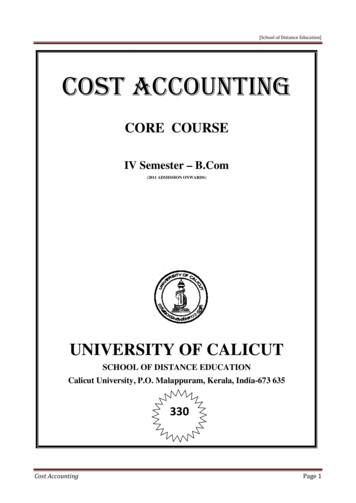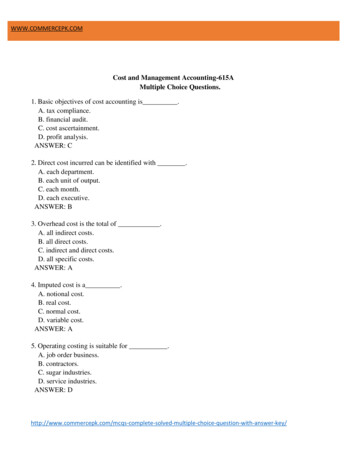
Transcription
To download more slides, ebook, solutions and test bank, visit http://downloadslide.blogspot.comCost Accounting, 14e (Horngren/Datar/Rajan)Chapter 8 Flexible Budgets, Overhead Cost Variances, and Management ControlObjective 8.11) Overhead costs have been increasing due to all of the following EXCEPT:A) increased automationB) more complexity in distribution processesC) tracing more costs as direct costs with the help of technologyD) product proliferationAnswer: CDiff: 3Terms: total-overhead varianceObjective: 1AACSB: Reflective thinking2) Effective planning of variable overhead costs means that a company performs those variable overheadcosts that primarily add value for:A) the current shareholdersB) the customer using the products or servicesC) plant employeesD) major suppliers of component partsAnswer: BDiff: 2Terms: total-overhead varianceObjective: 1AACSB: Reflective thinking3) Variable overhead costs include:A) plant-leasing costsB) the plant manager's salaryC) depreciation on plant equipmentD) machine maintenanceAnswer: DDiff: 1Terms: total-overhead varianceObjective: 1AACSB: Reflective thinking4) Fixed overhead costs include:A) the cost of sales commissionsB) property taxes paid on plant facilitiesC) energy costsD) indirect materialsAnswer: BDiff: 1Terms: total-overhead varianceObjective: 1AACSB: Reflective thinking1Copyright 2012 Pearson Education, Inc.
To download more slides, ebook, solutions and test bank, visit http://downloadslide.blogspot.com5) Effective planning of fixed overhead costs includes all of the following EXCEPT:A) planning day-to-day operational decisionsB) eliminating nonvalue-added costsC) planning to be efficientD) choosing the appropriate level of capacityAnswer: ADiff: 3Terms: total-overhead varianceObjective: 1AACSB: Reflective thinking6) Effective planning of variable overhead includes all of the following EXCEPT:A) choosing the appropriate level of capacityB) eliminating nonvalue-adding costsC) redesigning products to use fewer resourcesD) redesigning the plant layout for more efficient processingAnswer: ADiff: 2Terms: total-overhead varianceObjective: 1AACSB: Reflective thinking7) Choosing the appropriate level of capacity:A) is a key strategic decisionB) may lead to loss of sales if overestimatedC) may lead to idle capacity if underestimatedD) All of these answers are correct.Answer: ADiff: 2Terms: production-volume varianceObjective: 1AACSB: Ethical reasoning8) The major challenge when planning fixed overhead is:A) calculating total costsB) calculating the cost-allocation rateC) choosing the appropriate level of capacityD) choosing the appropriate planning periodAnswer: CDiff: 3Terms: production-volume varianceObjective: 1AACSB: Reflective thinking2Copyright 2012 Pearson Education, Inc.
To download more slides, ebook, solutions and test bank, visit http://downloadslide.blogspot.com9) Overhead costs are a major part of costs for most companies more than 50% of all costs for somecompanies.Answer: TRUEDiff: 1Terms: total-overhead varianceObjective: 1AACSB: Reflective thinking10) At the start of the budget period, management will have made most decisions regarding the level offixed overhead costs to be incurred.Answer: TRUEDiff: 1Terms: total-overhead varianceObjective: 1AACSB: Ethical reasoning11) One way to manage both variable and fixed overhead costs is to eliminate value-adding activities.Answer: FALSEExplanation: One way to manage both variable and fixed overhead costs is to eliminate non-valueadding activities.Diff: 1Terms: total-overhead varianceObjective: 1AACSB: Reflective thinking12) The planning of fixed overhead costs does NOT differ from the planning of variable overhead costs.Answer: FALSEExplanation: The planning of fixed overhead costs differs from the planning of variable overhead costsin one important respect, timing. The level of fixed costs to be incurred will have been mostly decidedupon at the start of the budget period, but the day-to-day ongoing operations decisions will be the maindeterminant in the level of variable overhead costs to be incurred in the period.Diff: 1Terms: total-overhead varianceObjective: 1AACSB: Reflective thinking3Copyright 2012 Pearson Education, Inc.
To download more slides, ebook, solutions and test bank, visit http://downloadslide.blogspot.com13) Jael Equipment uses a flexible budget for its indirect manufacturing costs. For 20X5, the companyanticipated that it would produce 18,000 units with 3,500 machine-hours and 7,200 employee days. Thecosts and cost drivers were to be as follows:Product d 30,0008,0004001,000Variable 0.408.004.000.205.00Cost driverper unitper 100 unit batchper 100 unit batchper machine-hourper employee dayDuring the year, the company processed 20,000 units, worked 7,500 employee days, and had 4,000machine-hours. The actual costs for 20X5 were:Product al costs 36,0009,0001,6001,20037,500Required:a.Prepare the static budget using the overhead items above and then compute the static-budgetvariances.b.Prepare the flexible budget using the overhead items above and then compute the flexible-budgetvariances.Answer:a.Product lJael EquipmentOverhead Static Budget with Variances20X5Actual 36,0009,0001,6001,20037,500 85,300StaticBudget 37,2009,4401,1201,70036,000 85,460Variances 1,200 F440 F480 U500 F1,500 U 160 F4Copyright 2012 Pearson Education, Inc.
To download more slides, ebook, solutions and test bank, visit http://downloadslide.blogspot.comb.Jael EquipmentOverhead Flexible Budget with Variances20X5FlexibleBudget 38,0009,6001,2001,80037,500 88,100ActualVariancesProduct handling 36,000 2,000 FInspection9,000600 FUtilities1,600400 UMaintenance1,200600 FSupplies37,5000Total 85,300 2,800 FDiff: 2Terms: fxd ovrhd flex-bud/spending, prod-vol, var ovrhd spending, var ovrhd efficiency varObjective: 1AACSB: Analytical skillsObjective 8.21) In a standard costing system, a cost-allocation base would most likely be:A) actual machine-hoursB) normal machine-hoursC) standard machine-hoursD) Any of these answers is correct.Answer: CDiff: 3Terms: standard costingObjective: 2AACSB: Reflective thinking2) For calculating the costs of products and services, a standard costing system:A) only requires a simple recording systemB) uses standard costs to determine the cost of productsC) does not have to keep track of actual costsD) All of these answers are correct.Answer: DDiff: 3Terms: standard costingObjective: 2AACSB: Reflective thinking5Copyright 2012 Pearson Education, Inc.
To download more slides, ebook, solutions and test bank, visit http://downloadslide.blogspot.com3) Which of the following is NOT a step in developing budgeted variable overhead rates?A) identifying the variable overhead costs associated with each cost-allocation baseB) estimating the budgeted denominator level based on expected utilization of available capacityC) selecting the cost-allocation bases to useD) choosing the period to be used for the budgetAnswer: BDiff: 2Terms: variable overhead rateObjective: 2AACSB: Analytical skills4) Which of the following is NOT a step in developing budgeted fixed overhead rates?A) Choose the period to use for the budget.B) Select the cost-allocation bases to use in allocating fixed overhead costs to output produced.C) Identify the fixed overhead costs associated with each cost-allocation base.D) All of the above are steps in developing budgeted fixed overhead rates.Answer: DDiff: 2Terms: fixed overhead rateObjective: 2AACSB: Analytical skills5) In flexible budgets, costs that remain the same regardless of the output levels within the relevantrange are:A) allocated costsB) budgeted costsC) fixed costsD) variable costsAnswer: CDiff: 1Terms: total-overhead varianceObjective: 2AACSB: Reflective thinking6Copyright 2012 Pearson Education, Inc.
To download more slides, ebook, solutions and test bank, visit http://downloadslide.blogspot.comAnswer the following questions using the information below:Willis Corporation manufactures industrial-sized gas furnaces and uses budgeted machine-hours toallocate variable manufacturing overhead. The following information pertains to the company'smanufacturing overhead data:Budgeted output units30,000 unitsBudgeted machine-hours10,000 hoursBudgeted variable manufacturing overhead costs for 15,000 units 322,500Actual output units producedActual machine-hours usedActual variable manufacturing overhead costs44,000 units14,400 hours 484,0006) What is the budgeted variable overhead cost rate per output unit?A) 10.75B) 11.00C) 32.25D) 48.40Answer: AExplanation: A) 322,500/30,000 10.75Diff: 2Terms: total-overhead varianceObjective: 2AACSB: Analytical skills7Copyright 2012 Pearson Education, Inc.
To download more slides, ebook, solutions and test bank, visit http://downloadslide.blogspot.comAnswer the following questions using the information below:Christine Corporation manufactures baseball uniforms and uses budgeted machine-hours to allocatevariable manufacturing overhead. The following information pertains to the company's manufacturingoverhead data:Budgeted output units10,000 unitsBudgeted machine-hours15,000 hoursBudgeted variable manufacturing overhead costs for 20,000 units 180,000Actual output units producedActual machine-hours usedActual variable manufacturing overhead costs9,000 units14,000 hours 171,0007) What is the budgeted variable overhead cost rate per output unit?A) 12.00B) 12.21C) 18.00D) 19.00Answer: CExplanation: C) 180,000/10,000 18.00Diff: 2Terms: total-overhead varianceObjective: 2AACSB: Analytical skills8Copyright 2012 Pearson Education, Inc.
To download more slides, ebook, solutions and test bank, visit http://downloadslide.blogspot.comAnswer the following questions using the information below:Fearless Frank's Fertilizer Farm produces fertilizer and distributes the product by using his tanker trucks.Frank's uses budgeted fleet hours to allocate variable manufacturing overhead. The followinginformation pertains to the company's manufacturing overhead data:Budgeted output units600 truckloadsBudgeted fleet hours450 hoursBudgeted pounds of fertilizer24,000,000 poundsBudgeted variable manufacturing overhead costs for 600 loads 75,000Actual output units produced and deliveredActual fleet hoursActual pounds of fertilizer produced and deliveredActual variable manufacturing overhead costs630 truckloads436 hours25,200,000 pounds 76,5008) What is the budgeted variable overhead cost rate per output unit?A) 120.00B) 125.00C) 166.67D) 175.00Answer: BExplanation: B) 75,000/600 125.00Diff: 2Terms: total-overhead varianceObjective: 2AACSB: Analytical skills9) Standard costing is a costing system that allocates overhead costs on the basis of the standardoverhead-cost rates times the standard quantities of the allocation bases allowed for the actual outputsproduced.Answer: TRUEDiff: 1Terms: standard costingObjective: 2AACSB: Reflective thinking10) For calculating the cost of products and services, a standard costing system must track actual costs.Answer: FALSEExplanation: For calculating the cost of products and services, a standard costing system does not haveto track actual costs.Diff: 3Terms: standard costingObjective: 2AACSB: Reflective thinking9Copyright 2012 Pearson Education, Inc.
To download more slides, ebook, solutions and test bank, visit http://downloadslide.blogspot.com11) Standard costing is a cost system that allocates overhead costs on the basis of overhead cost ratesbased on actual overhead costs times the standard quantities of the allocation bases allowed for theactual outputs produced.Answer: FALSEExplanation: Standard costing is a costing system that traces direct costs to output produced bymultiplying the standard prices or rates by the standard quantities of inputs allowed for actual outputsproduced.Diff: 3Terms: standard costingObjective: 2AACSB: Reflective thinking12) The budget period for variable-overhead costs is typically less than 3 months.Answer: FALSEExplanation: The budget period for variable-overhead costs is typically 12 months.Diff: 1Terms: total-overhead varianceObjective: 2AACSB: Reflective thinkingObjective 8.31) The variable overhead flexible-budget variance measures the difference between:A) actual variable overhead costs and the static budget for variable overhead costsB) actual variable overhead costs and the flexible budget for variable overhead costsC) the static budget for variable overhead costs and the flexible budget for variable overhead costsD) None of these answers is correct.Answer: BDiff: 2Terms: variable overhead flexible-budget varianceObjective: 3AACSB: Reflective thinking2) A 5,000 unfavorable flexible-budget variance indicates that:A) the flexible-budget amount exceeded actual variable manufacturing overhead by 5,000B) the actual variable manufacturing overhead exceeded the flexible-budget amount by 5,000C) the flexible-budget amount exceeded standard variable manufacturing overhead by 5,000D) the standard variable manufacturing overhead exceeded the flexible-budget amount by 5,000Answer: BDiff: 2Terms: variable overhead flexible-budget varianceObjective: 3AACSB: Analytical skills10Copyright 2012 Pearson Education, Inc.
To download more slides, ebook, solutions and test bank, visit http://downloadslide.blogspot.comAnswer the following questions using the information below:Willis Corporation manufactures industrial-sized gas furnaces and uses budgeted machine-hours toallocate variable manufacturing overhead. The following information pertains to the company'smanufacturing overhead data:Budgeted output units30,000 unitsBudgeted machine-hours10,000 hoursBudgeted variable manufacturing overhead costs for 15,000 units 322,500Actual output units producedActual machine-hours usedActual variable manufacturing overhead costs44,000
Cost Accounting, 14e (Horngren/Datar/Rajan) Chapter 8 Flexible Budgets, Overhead Cost Variances, and Management Control Objective 8.1 1) Overhead costs have been increasing due to all of the following EXCEPT: A) increased automation B) more complexity in distribution processes C) tracing more costs as direct costs with the help of technology D) product proliferation Answer: C Diff: 3 Terms .










